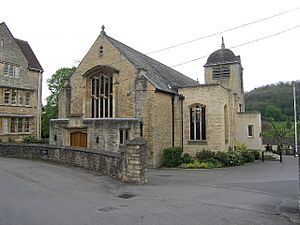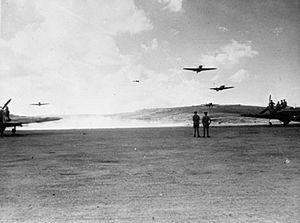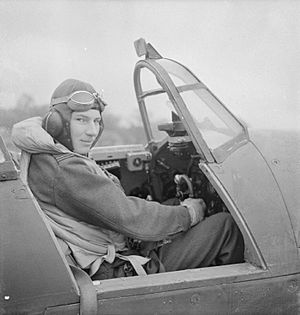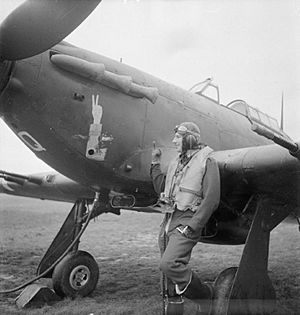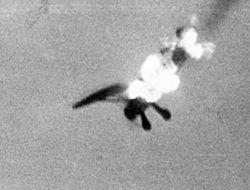James MacLachlan facts for kids
Quick facts for kids
James Archibald Findlay MacLachlan
|
|
|---|---|
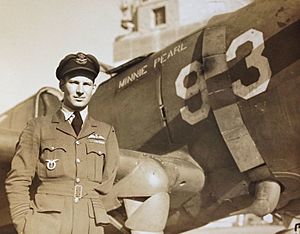
MacLachlan in front of a P-36 Hawk during a visit to the United States, 1943
|
|
| Nickname(s) | "One-Armed Mac" |
| Born | 1 April 1919 Styal, England |
| Died | 31 July 1943 (aged 24) Pont-l'Évêque, German-occupied France |
| Buried |
Pont-l'Évêque, Calvados, France
|
| Allegiance | United Kingdom |
| Service/ |
Royal Air Force |
| Years of service | 1937–1943 |
| Rank | Squadron leader |
| Commands held | No. 1 Squadron RAF |
| Battles/wars | Second World War |
| Awards | Distinguished Service Order Distinguished Flying Cross & Two Bars War Cross (Czechoslovakia) |
James Archibald Findlay MacLachlan (born April 1, 1919 – died July 31, 1943) was a brave Royal Air Force (RAF) fighter pilot and a "flying ace" during the Second World War. This means he shot down many enemy aircraft. MacLachlan was officially credited with destroying 16 German and Italian planes. He flew about 250 missions, with 7 of his victories happening at night.
Born in Cheshire, England, James joined the RAF when he was 17. He quickly became a pilot. When the Battle of France started in May 1940, he flew a Fairey Battle bomber. He was recognized for his bravery and received the Distinguished Flying Cross (DFC).
After surviving the Battle of France, he became a fighter pilot. He flew during the Battle of Britain in 1940. Later, he moved to Malta and became a very successful pilot there, even shooting down two planes at night. In February 1941, he was badly injured and lost an arm. But James was incredibly determined! He returned to flying in November 1941 with an artificial arm.
He then led night fighter missions defending Britain. By May 1942, he had shot down five more planes at night, making him a "night fighter ace." He received the Distinguished Service Order (DSO) for his amazing courage. By July 1942, James had shot down 13 enemy aircraft, with 7 of them at night. He continued to fly and achieved his last 3 victories in one mission, bringing his total to 16.
Sadly, on July 18, 1943, his P-51 Mustang plane was hit over France. He crashed and was taken prisoner by the Germans. He died from his injuries in a hospital on July 31, 1943. James MacLachlan was a true hero who never gave up, even after a severe injury.
Contents
Early Life and Dreams of Flying
James MacLachlan was born on April 1, 1919, in Styal, Cheshire. He was the second of six children. His father passed away when James was young, and his family moved to Southampton.
James went to Monkton Combe School near Bath, Somerset starting in September 1931, when he was 12. He wasn't the best student in academics, but he loved poetry. He also enjoyed carpentry and metal work. He even built a small pistol with friends in the school workshops!
When he was 17, James took a five-shilling flight at an RAF open day. This experience made him decide he wanted to be a pilot. He joined the Royal Air Force (RAF) in March 1937, just before his 18th birthday.
Becoming an RAF Pilot
James started his flight training on March 1, 1937. His first flight was in a Tiger Moth plane. Just a week later, he flew solo for the first time! He loved flying, even though it was a bit scary at first. He wrote, "I simply love flying."
He quickly moved through his training. In May 1937, he became an acting pilot officer. He learned to fly faster planes like the Hawker Hart and Hawker Audax. He was rated an "above average" pilot.
James chose to fly with light bomber squadrons. He practiced dive-bombing and other attack methods. He also loved air-to-air gunnery, which is shooting at other planes. By November 1937, he had 92 hours of flying experience. He joined No. 88 Squadron RAF, which was getting new Fairey Battle planes. By the time the war began in September 1939, James had two years of experience flying these aircraft.
World War II Begins
When Germany invaded Poland on September 1, 1939, Britain and its allies declared war. James's squadron moved to France. At first, there wasn't much fighting. However, it soon became clear that the Fairey Battle bomber was too slow and not well-armed enough to defend itself against German fighters.
On October 26, James was promoted to flying officer. He continued to fly missions, even when his plane was damaged. The squadron settled down for the winter. On May 10, 1940, the "Phoney War" ended when Germany invaded Western Europe.
Fighting in France
James's squadron faced heavy attacks from German planes. Their airfield was bombed, and they lost several aircraft. On May 14, James flew his first mission over the Sedan bridgeheads. This was a very dangerous mission, as German forces were breaking through. Many Allied planes were lost that day.
On May 19, his squadron started flying night missions because the German air force was so strong during the day. James flew missions against German targets. On May 21, he flew low over German tank units. His observer, Sergeant Hardy, was so worried about James's low-level flying that he asked to be moved to another crew. Sadly, Hardy was shot down and killed on his next mission with a new pilot.
On June 10, James's plane was hit by ground fire, and his cockpit hood was shot away, but he wasn't hurt. On June 14, the squadron left France as the Allied forces were losing ground. They flew back to Britain. James even flew low over his old school to say goodbye! For his brave actions during the Battle of France, James received the Distinguished Flying Cross (DFC).
From Britain to Malta
James wanted to get back into action. He volunteered to become a fighter pilot during the Battle of Britain, which had started in July 1940. He began training to fly the Hawker Hurricane fighter. On September 3, he received his DFC medal at Buckingham Palace.
He then joined No. 73 Squadron RAF and flew patrols. On October 7, he had his first air combat as a fighter pilot. He spotted two German Bf 109 fighters and managed to hit one, which flew away smoking. This was a "probable victory."
Two weeks later, James was sent to Malta. This island was very important because it was located on Italian supply routes in the Mediterranean. Italy and Germany wanted to capture Malta, so they bombed it heavily. James arrived on Malta in January 1941.
Hero in Malta
On January 9, James quickly showed his skill. He spotted Italian fighters and shot one down into the sea. He then shot down a second plane minutes later. The next day, he attacked an Italian bomber over a convoy of ships.
On January 19, James was in action against German dive bombers. He shot down one Junkers Ju 87 and then another that was trying to sneak past defenses. He then shot down an Italian fighter. These victories made him a "flying ace," meaning he had shot down five or more enemy planes.
He continued to fight bravely, shooting down a bomber and a Junkers Ju 88. For his amazing actions, he received a Bar to his DFC on January 24. This meant he got a second DFC award. On February 9, he claimed a night victory, a German bomber.
However, new German Bf 109 fighters arrived in Malta, and they were faster than the Hurricanes. On February 16, 1941, James's Hurricane was hit by cannon fire during a battle with Bf 109s. His left arm was badly wounded. He managed to bail out of his plane and land safely.
James was taken to the hospital. His arm was so badly damaged that it had to be amputated below the elbow. But James was incredibly determined! While in the hospital, he even talked to an Italian pilot he had shot down earlier. He was so eager to fly again that nurses and his squadron mates made bets on whether he would return to action. He won the bet by taking a flight in a transport plane just a few weeks after his operation.
Return to Flying: The One-Armed Ace
James returned to Britain and was fitted with a special artificial arm. Doctors designed it so he could still operate the controls of a Hurricane plane. The arm had spring-loaded pins that acted like fingers, allowing him to use the throttle and other levers. He practiced flying as much as possible. Even with a new arm, he was cleared for operational flying on October 15, 1941.
On November 3, 1941, James was promoted to squadron leader and given command of No. 1 Squadron RAF. They flew Hawker Hurricane Mk. IIc planes for night "intruder" operations over Europe. James even had a special emblem painted on his plane: a left arm with a cannon shell through it, making a "V for Victory" sign.
He found it hard to spot German planes in the dark at first. But on April 1, 1942, his 23rd birthday, his squadron had its first success. James himself destroyed two locomotives (train engines) and damaged a tug boat on the Seine river.
In May 1942, James was told he would receive the Distinguished Service Order (DSO), a very high award for bravery. His total victories were now 11. He became known as a skilled night flyer and ground-attack ace. The BBC even interviewed him about his exciting night fighter missions.
On June 3, 1942, James had an amazing night. He flew into a group of German bombers as they were getting ready to land. In just 14 seconds, he shot down two bombers and damaged two more! He was incredibly fast and precise. This brought his total to 13 victories. This was his last victory with the squadron before he moved to a new role as an instructor.
Touring America and Final Missions
In October 1942, James was chosen to go to the United States. He would lecture British and American pilot trainees. He traveled across America, visiting many flight schools. He even got to fly different types of American planes, like the Curtiss P-40 Warhawk and Lockheed P-38 Lightning. He enjoyed his time in America, meeting movie stars and flying in aerobatic shows.
James returned to Britain in April 1943. He was sad to learn that his brother Gordon, also a pilot, had been shot down and killed over France. This made James even more determined to get back into combat.
He started flying the P-51 Mustang plane, which was very powerful. James wanted to fly dangerous "Ranger" missions deep into enemy territory. He had developed new tactics for flying at very low altitudes to avoid detection.
He teamed up with another brave pilot, Geoffrey Page, who had also been badly burned in battle. Page joked, "Fine bloody pair we are, going off to tackle the enemy with only one good hand between us!"
On June 29, 1943, James and Page flew their mission. They spotted a group of German training planes and shot down four of them, with James destroying two. They then found two German night fighters coming in to land and destroyed both of them. This brought James's total victories to 16. For this incredible mission, James received a second Bar to his DFC, meaning he had been awarded the DFC three times!
On July 18, 1943, James was on another mission. His Mustang plane was likely hit by ground fire near the French coast. His plane crashed, and he was taken prisoner by the Germans. He was severely injured and died 13 days later, on July 31, 1943, in a German hospital.
James MacLachlan was buried in France. French civilians secretly placed flowers on his grave and a wooden plaque that said, "He died so France might live." The Germans quickly removed it, but his bravery was remembered. James MacLachlan was a true hero who overcame a terrible injury to continue fighting for his country.
Awards and Recognition
James MacLachlan received several important awards for his bravery and skill:
- Distinguished Flying Cross (DFC) – Awarded on July 16, 1940, for his courage during flying operations against the enemy.
- Bar to the DFC – Awarded on February 11, 1941, for his amazing actions in Malta. He destroyed four or five enemy aircraft in one day and had chased another far out to sea. He showed great courage and leadership.
- Distinguished Service Order (DSO) – Awarded on May 29, 1942. This recognized his eight victories in the Middle East and his incredible return to flying after losing his arm. He had great success in night flying, shooting down bombers and attacking trains and barges. He was an inspiration to all pilots.
- Second Bar to the DFC – Awarded on July 30, 1943 (after his death). This was for the mission where he and Flight Lieutenant Page shot down six enemy aircraft, with James destroying three of them. The operation was planned by James and was brilliantly carried out.
- Czechoslovak War Cross 1939–1945 – Awarded on August 11, 1942, by the President of Czechoslovakia for his contributions to the war effort.
|


